Health Promotion Report: Mental Health Awareness in Youth
VerifiedAdded on 2020/05/16
|24
|4724
|225
Report
AI Summary
This report focuses on the importance of health promotion concerning youth mental health, particularly in addressing depression. It identifies various risk factors associated with depression among the youth, including family history, trauma, peer pressure, and socio-economic issues. The report also explores the role of personality types in the development of depression and highlights barriers to accessing mental healthcare services such as lack of awareness, poor access, and stigma. It then details intervention strategies like therapeutic lifestyle changes, stress management techniques, and positive psychotherapy to increase awareness and reduce depressive symptoms. The report further outlines evaluation strategies to determine the effectiveness of the interventions, including action plans, implementation, and feedback mechanisms, ultimately aiming to promote mental well-being among the youth population. The report utilizes the health belief model to design its health campaign and discusses coping strategies, life chances, and the impact of socio-demographic factors on mental health. It also examines existing policies and provides a comprehensive approach to tackling mental health challenges in young people.
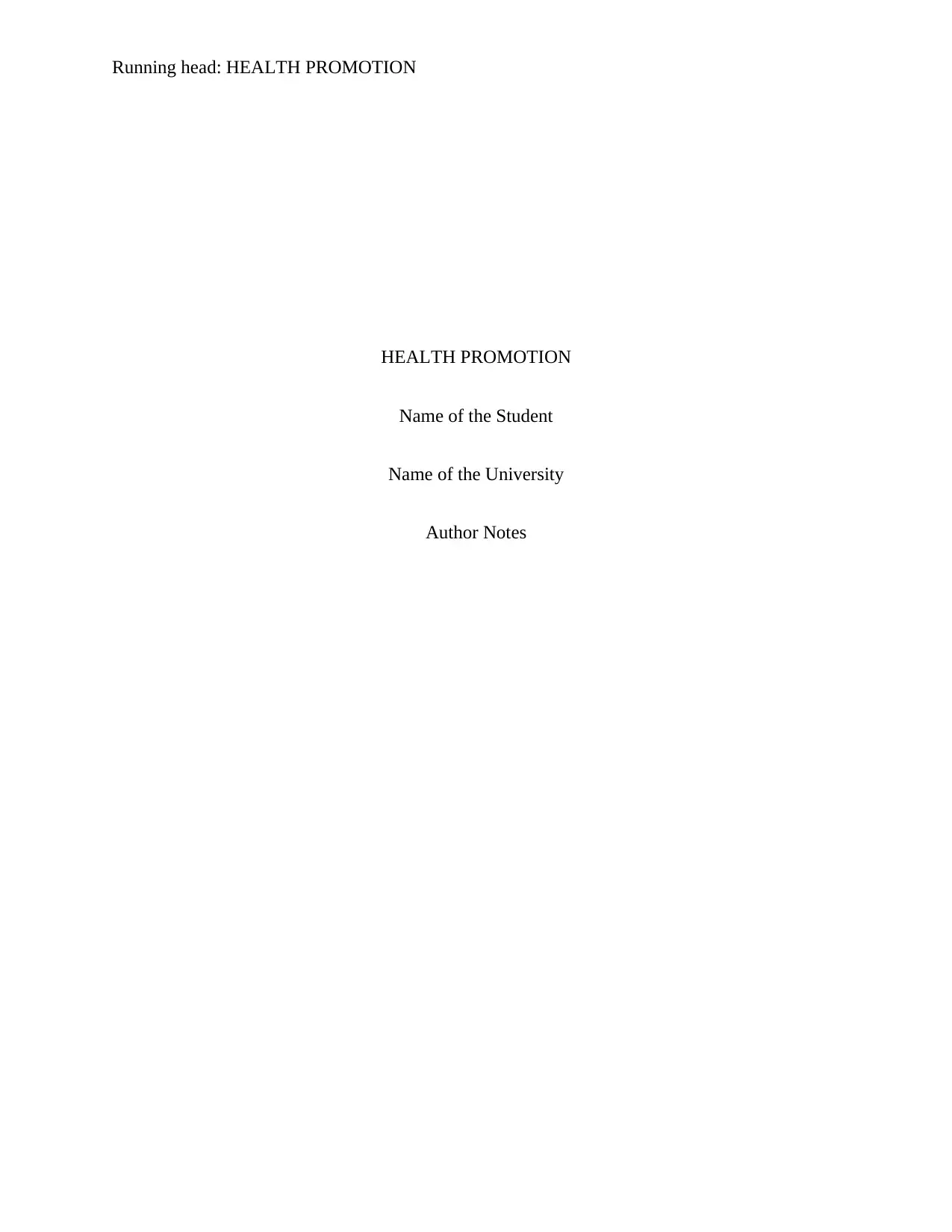
Running head: HEALTH PROMOTION
HEALTH PROMOTION
Name of the Student
Name of the University
Author Notes
HEALTH PROMOTION
Name of the Student
Name of the University
Author Notes
Paraphrase This Document
Need a fresh take? Get an instant paraphrase of this document with our AI Paraphraser
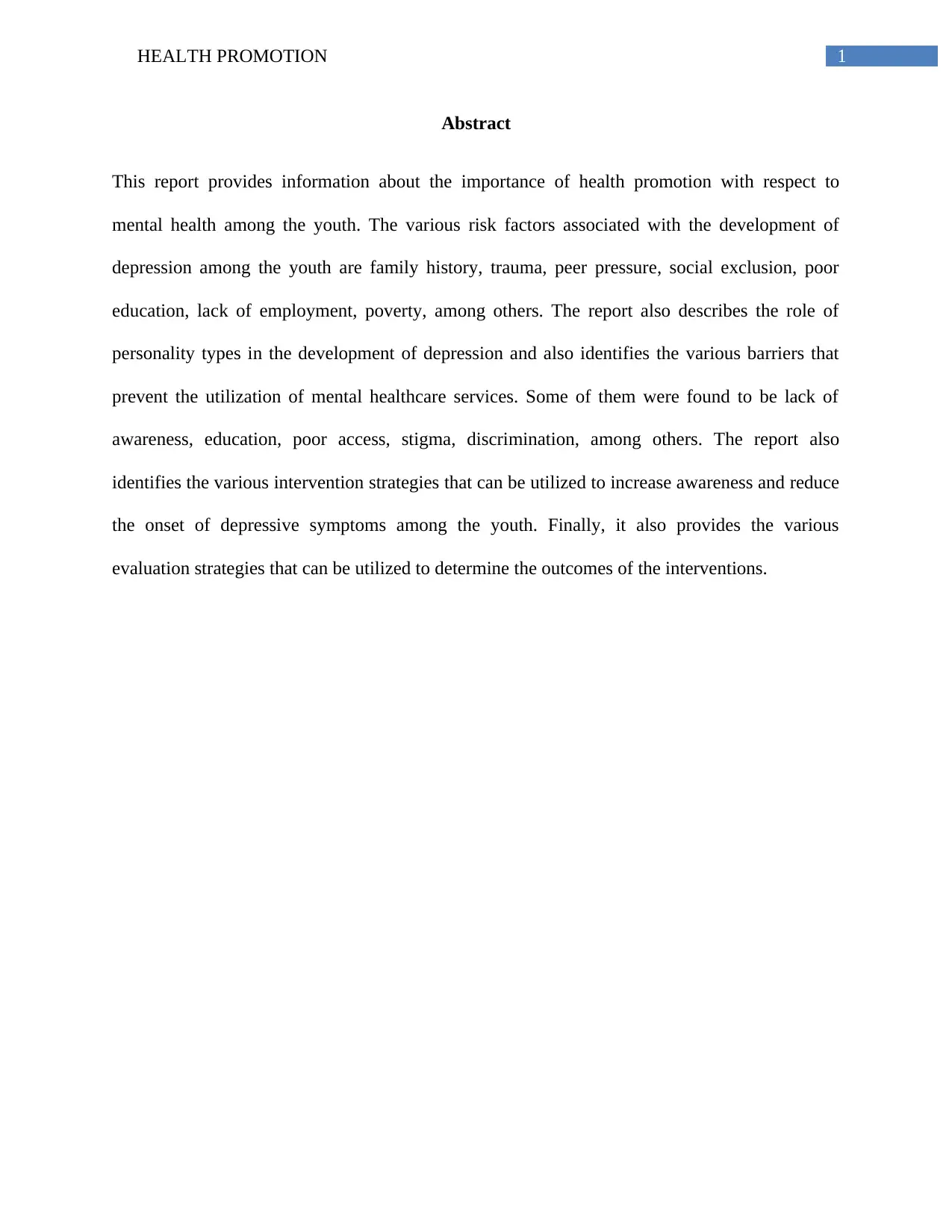
1HEALTH PROMOTION
Abstract
This report provides information about the importance of health promotion with respect to
mental health among the youth. The various risk factors associated with the development of
depression among the youth are family history, trauma, peer pressure, social exclusion, poor
education, lack of employment, poverty, among others. The report also describes the role of
personality types in the development of depression and also identifies the various barriers that
prevent the utilization of mental healthcare services. Some of them were found to be lack of
awareness, education, poor access, stigma, discrimination, among others. The report also
identifies the various intervention strategies that can be utilized to increase awareness and reduce
the onset of depressive symptoms among the youth. Finally, it also provides the various
evaluation strategies that can be utilized to determine the outcomes of the interventions.
Abstract
This report provides information about the importance of health promotion with respect to
mental health among the youth. The various risk factors associated with the development of
depression among the youth are family history, trauma, peer pressure, social exclusion, poor
education, lack of employment, poverty, among others. The report also describes the role of
personality types in the development of depression and also identifies the various barriers that
prevent the utilization of mental healthcare services. Some of them were found to be lack of
awareness, education, poor access, stigma, discrimination, among others. The report also
identifies the various intervention strategies that can be utilized to increase awareness and reduce
the onset of depressive symptoms among the youth. Finally, it also provides the various
evaluation strategies that can be utilized to determine the outcomes of the interventions.
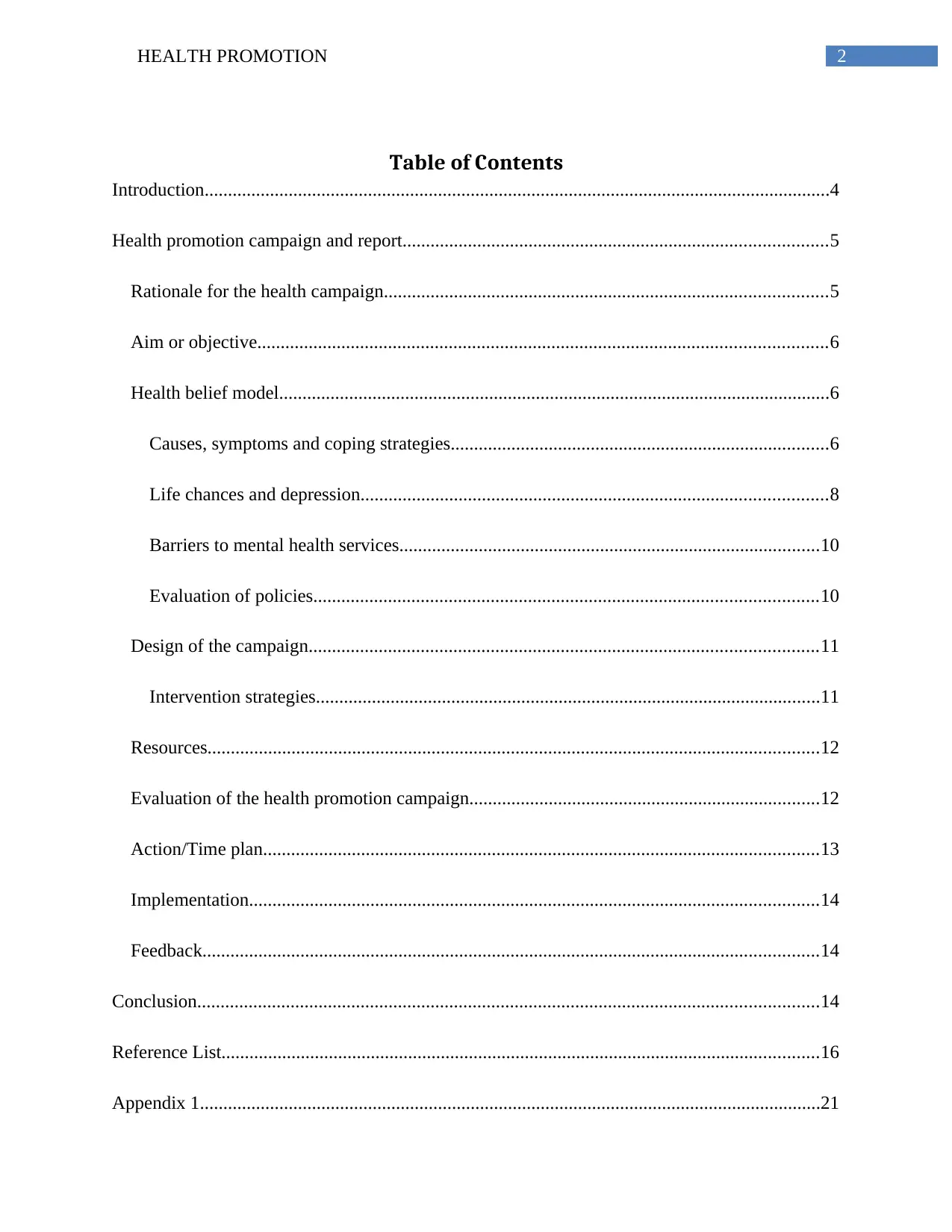
2HEALTH PROMOTION
Table of Contents
Introduction......................................................................................................................................4
Health promotion campaign and report...........................................................................................5
Rationale for the health campaign...............................................................................................5
Aim or objective..........................................................................................................................6
Health belief model......................................................................................................................6
Causes, symptoms and coping strategies.................................................................................6
Life chances and depression....................................................................................................8
Barriers to mental health services..........................................................................................10
Evaluation of policies............................................................................................................10
Design of the campaign.............................................................................................................11
Intervention strategies............................................................................................................11
Resources...................................................................................................................................12
Evaluation of the health promotion campaign...........................................................................12
Action/Time plan.......................................................................................................................13
Implementation..........................................................................................................................14
Feedback....................................................................................................................................14
Conclusion.....................................................................................................................................14
Reference List................................................................................................................................16
Appendix 1.....................................................................................................................................21
Table of Contents
Introduction......................................................................................................................................4
Health promotion campaign and report...........................................................................................5
Rationale for the health campaign...............................................................................................5
Aim or objective..........................................................................................................................6
Health belief model......................................................................................................................6
Causes, symptoms and coping strategies.................................................................................6
Life chances and depression....................................................................................................8
Barriers to mental health services..........................................................................................10
Evaluation of policies............................................................................................................10
Design of the campaign.............................................................................................................11
Intervention strategies............................................................................................................11
Resources...................................................................................................................................12
Evaluation of the health promotion campaign...........................................................................12
Action/Time plan.......................................................................................................................13
Implementation..........................................................................................................................14
Feedback....................................................................................................................................14
Conclusion.....................................................................................................................................14
Reference List................................................................................................................................16
Appendix 1.....................................................................................................................................21
⊘ This is a preview!⊘
Do you want full access?
Subscribe today to unlock all pages.

Trusted by 1+ million students worldwide

3HEALTH PROMOTION
Appendix 2.....................................................................................................................................22
Appendix 3.....................................................................................................................................23
Appendix 2.....................................................................................................................................22
Appendix 3.....................................................................................................................................23
Paraphrase This Document
Need a fresh take? Get an instant paraphrase of this document with our AI Paraphraser
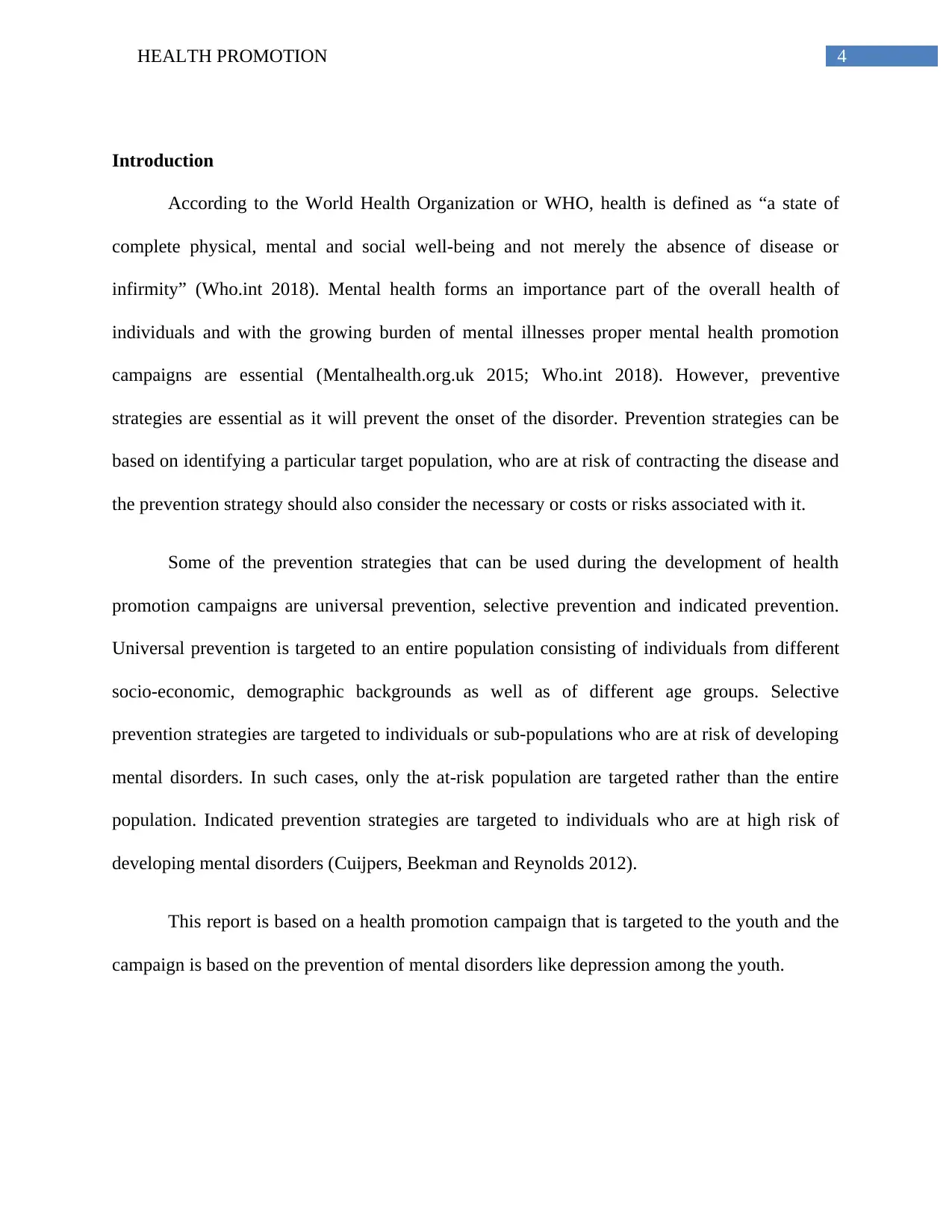
4HEALTH PROMOTION
Introduction
According to the World Health Organization or WHO, health is defined as “a state of
complete physical, mental and social well-being and not merely the absence of disease or
infirmity” (Who.int 2018). Mental health forms an importance part of the overall health of
individuals and with the growing burden of mental illnesses proper mental health promotion
campaigns are essential (Mentalhealth.org.uk 2015; Who.int 2018). However, preventive
strategies are essential as it will prevent the onset of the disorder. Prevention strategies can be
based on identifying a particular target population, who are at risk of contracting the disease and
the prevention strategy should also consider the necessary or costs or risks associated with it.
Some of the prevention strategies that can be used during the development of health
promotion campaigns are universal prevention, selective prevention and indicated prevention.
Universal prevention is targeted to an entire population consisting of individuals from different
socio-economic, demographic backgrounds as well as of different age groups. Selective
prevention strategies are targeted to individuals or sub-populations who are at risk of developing
mental disorders. In such cases, only the at-risk population are targeted rather than the entire
population. Indicated prevention strategies are targeted to individuals who are at high risk of
developing mental disorders (Cuijpers, Beekman and Reynolds 2012).
This report is based on a health promotion campaign that is targeted to the youth and the
campaign is based on the prevention of mental disorders like depression among the youth.
Introduction
According to the World Health Organization or WHO, health is defined as “a state of
complete physical, mental and social well-being and not merely the absence of disease or
infirmity” (Who.int 2018). Mental health forms an importance part of the overall health of
individuals and with the growing burden of mental illnesses proper mental health promotion
campaigns are essential (Mentalhealth.org.uk 2015; Who.int 2018). However, preventive
strategies are essential as it will prevent the onset of the disorder. Prevention strategies can be
based on identifying a particular target population, who are at risk of contracting the disease and
the prevention strategy should also consider the necessary or costs or risks associated with it.
Some of the prevention strategies that can be used during the development of health
promotion campaigns are universal prevention, selective prevention and indicated prevention.
Universal prevention is targeted to an entire population consisting of individuals from different
socio-economic, demographic backgrounds as well as of different age groups. Selective
prevention strategies are targeted to individuals or sub-populations who are at risk of developing
mental disorders. In such cases, only the at-risk population are targeted rather than the entire
population. Indicated prevention strategies are targeted to individuals who are at high risk of
developing mental disorders (Cuijpers, Beekman and Reynolds 2012).
This report is based on a health promotion campaign that is targeted to the youth and the
campaign is based on the prevention of mental disorders like depression among the youth.
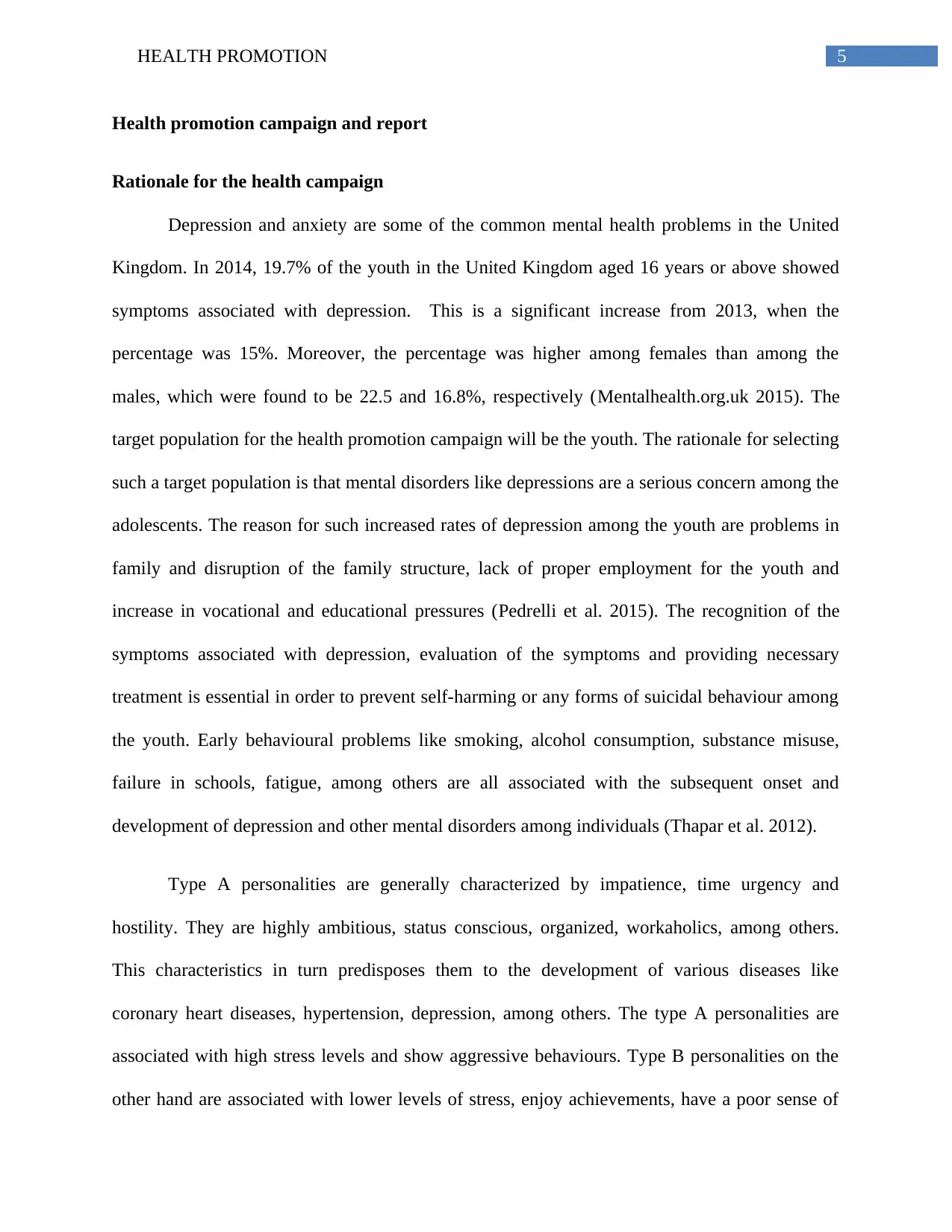
5HEALTH PROMOTION
Health promotion campaign and report
Rationale for the health campaign
Depression and anxiety are some of the common mental health problems in the United
Kingdom. In 2014, 19.7% of the youth in the United Kingdom aged 16 years or above showed
symptoms associated with depression. This is a significant increase from 2013, when the
percentage was 15%. Moreover, the percentage was higher among females than among the
males, which were found to be 22.5 and 16.8%, respectively (Mentalhealth.org.uk 2015). The
target population for the health promotion campaign will be the youth. The rationale for selecting
such a target population is that mental disorders like depressions are a serious concern among the
adolescents. The reason for such increased rates of depression among the youth are problems in
family and disruption of the family structure, lack of proper employment for the youth and
increase in vocational and educational pressures (Pedrelli et al. 2015). The recognition of the
symptoms associated with depression, evaluation of the symptoms and providing necessary
treatment is essential in order to prevent self-harming or any forms of suicidal behaviour among
the youth. Early behavioural problems like smoking, alcohol consumption, substance misuse,
failure in schools, fatigue, among others are all associated with the subsequent onset and
development of depression and other mental disorders among individuals (Thapar et al. 2012).
Type A personalities are generally characterized by impatience, time urgency and
hostility. They are highly ambitious, status conscious, organized, workaholics, among others.
This characteristics in turn predisposes them to the development of various diseases like
coronary heart diseases, hypertension, depression, among others. The type A personalities are
associated with high stress levels and show aggressive behaviours. Type B personalities on the
other hand are associated with lower levels of stress, enjoy achievements, have a poor sense of
Health promotion campaign and report
Rationale for the health campaign
Depression and anxiety are some of the common mental health problems in the United
Kingdom. In 2014, 19.7% of the youth in the United Kingdom aged 16 years or above showed
symptoms associated with depression. This is a significant increase from 2013, when the
percentage was 15%. Moreover, the percentage was higher among females than among the
males, which were found to be 22.5 and 16.8%, respectively (Mentalhealth.org.uk 2015). The
target population for the health promotion campaign will be the youth. The rationale for selecting
such a target population is that mental disorders like depressions are a serious concern among the
adolescents. The reason for such increased rates of depression among the youth are problems in
family and disruption of the family structure, lack of proper employment for the youth and
increase in vocational and educational pressures (Pedrelli et al. 2015). The recognition of the
symptoms associated with depression, evaluation of the symptoms and providing necessary
treatment is essential in order to prevent self-harming or any forms of suicidal behaviour among
the youth. Early behavioural problems like smoking, alcohol consumption, substance misuse,
failure in schools, fatigue, among others are all associated with the subsequent onset and
development of depression and other mental disorders among individuals (Thapar et al. 2012).
Type A personalities are generally characterized by impatience, time urgency and
hostility. They are highly ambitious, status conscious, organized, workaholics, among others.
This characteristics in turn predisposes them to the development of various diseases like
coronary heart diseases, hypertension, depression, among others. The type A personalities are
associated with high stress levels and show aggressive behaviours. Type B personalities on the
other hand are associated with lower levels of stress, enjoy achievements, have a poor sense of
⊘ This is a preview!⊘
Do you want full access?
Subscribe today to unlock all pages.

Trusted by 1+ million students worldwide
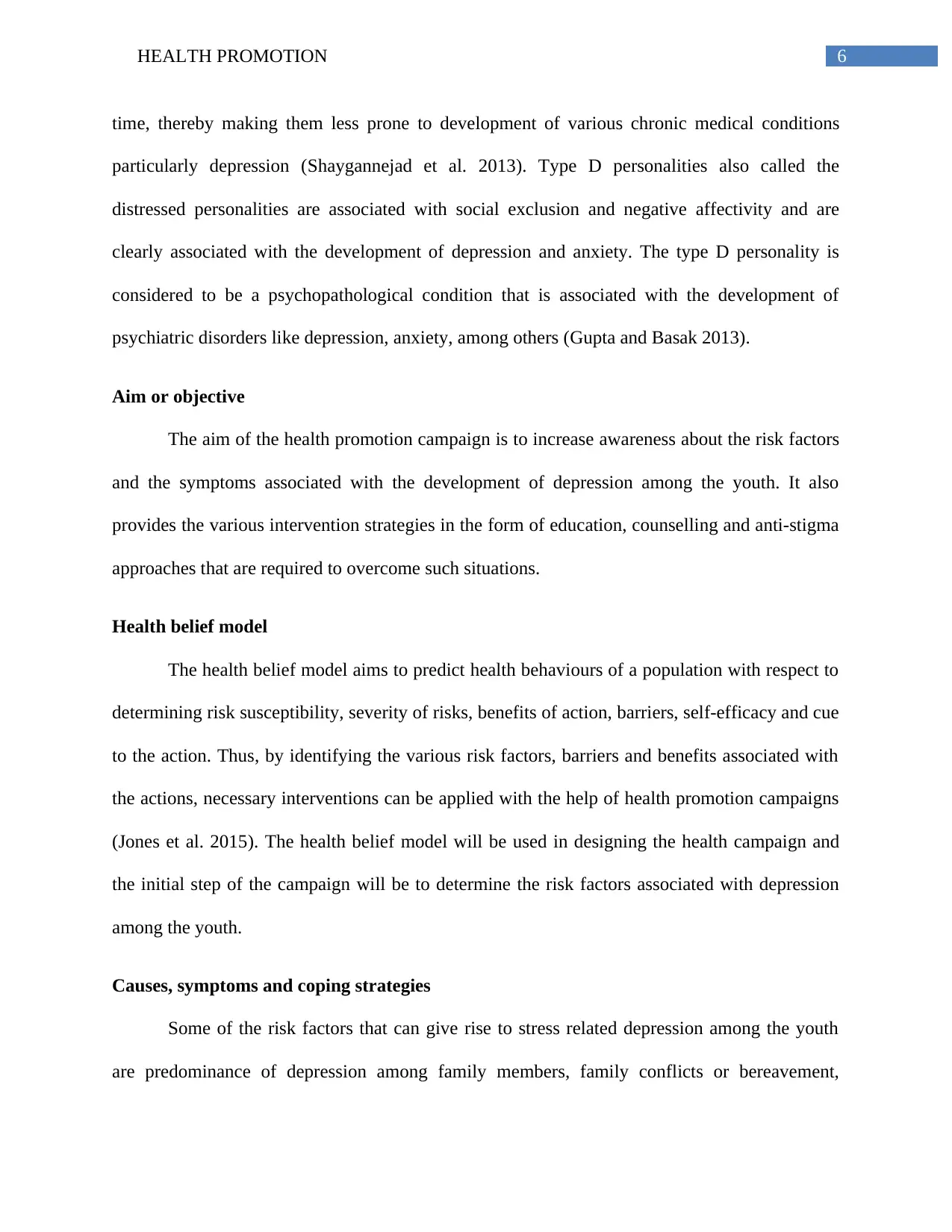
6HEALTH PROMOTION
time, thereby making them less prone to development of various chronic medical conditions
particularly depression (Shaygannejad et al. 2013). Type D personalities also called the
distressed personalities are associated with social exclusion and negative affectivity and are
clearly associated with the development of depression and anxiety. The type D personality is
considered to be a psychopathological condition that is associated with the development of
psychiatric disorders like depression, anxiety, among others (Gupta and Basak 2013).
Aim or objective
The aim of the health promotion campaign is to increase awareness about the risk factors
and the symptoms associated with the development of depression among the youth. It also
provides the various intervention strategies in the form of education, counselling and anti-stigma
approaches that are required to overcome such situations.
Health belief model
The health belief model aims to predict health behaviours of a population with respect to
determining risk susceptibility, severity of risks, benefits of action, barriers, self-efficacy and cue
to the action. Thus, by identifying the various risk factors, barriers and benefits associated with
the actions, necessary interventions can be applied with the help of health promotion campaigns
(Jones et al. 2015). The health belief model will be used in designing the health campaign and
the initial step of the campaign will be to determine the risk factors associated with depression
among the youth.
Causes, symptoms and coping strategies
Some of the risk factors that can give rise to stress related depression among the youth
are predominance of depression among family members, family conflicts or bereavement,
time, thereby making them less prone to development of various chronic medical conditions
particularly depression (Shaygannejad et al. 2013). Type D personalities also called the
distressed personalities are associated with social exclusion and negative affectivity and are
clearly associated with the development of depression and anxiety. The type D personality is
considered to be a psychopathological condition that is associated with the development of
psychiatric disorders like depression, anxiety, among others (Gupta and Basak 2013).
Aim or objective
The aim of the health promotion campaign is to increase awareness about the risk factors
and the symptoms associated with the development of depression among the youth. It also
provides the various intervention strategies in the form of education, counselling and anti-stigma
approaches that are required to overcome such situations.
Health belief model
The health belief model aims to predict health behaviours of a population with respect to
determining risk susceptibility, severity of risks, benefits of action, barriers, self-efficacy and cue
to the action. Thus, by identifying the various risk factors, barriers and benefits associated with
the actions, necessary interventions can be applied with the help of health promotion campaigns
(Jones et al. 2015). The health belief model will be used in designing the health campaign and
the initial step of the campaign will be to determine the risk factors associated with depression
among the youth.
Causes, symptoms and coping strategies
Some of the risk factors that can give rise to stress related depression among the youth
are predominance of depression among family members, family conflicts or bereavement,
Paraphrase This Document
Need a fresh take? Get an instant paraphrase of this document with our AI Paraphraser
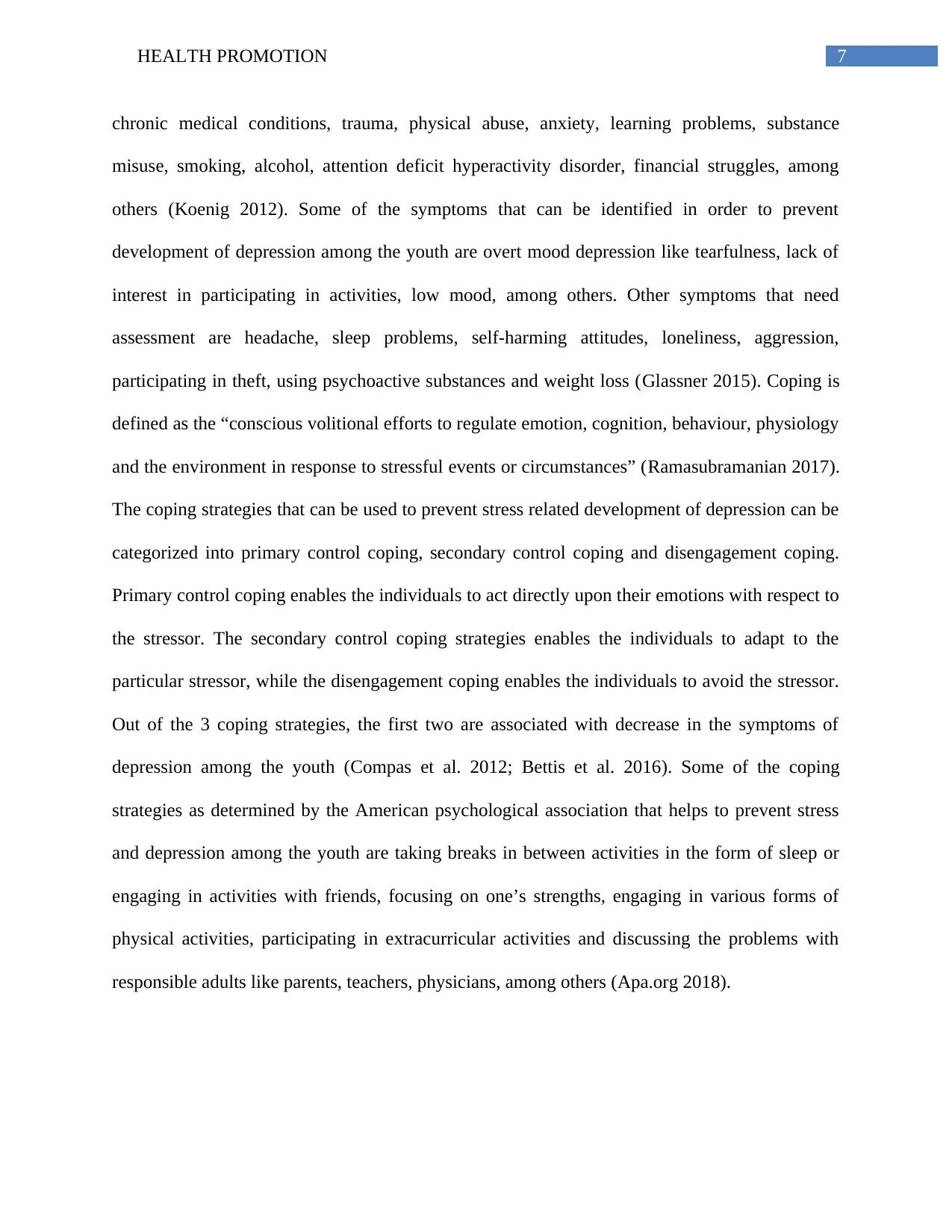
7HEALTH PROMOTION
chronic medical conditions, trauma, physical abuse, anxiety, learning problems, substance
misuse, smoking, alcohol, attention deficit hyperactivity disorder, financial struggles, among
others (Koenig 2012). Some of the symptoms that can be identified in order to prevent
development of depression among the youth are overt mood depression like tearfulness, lack of
interest in participating in activities, low mood, among others. Other symptoms that need
assessment are headache, sleep problems, self-harming attitudes, loneliness, aggression,
participating in theft, using psychoactive substances and weight loss (Glassner 2015). Coping is
defined as the “conscious volitional efforts to regulate emotion, cognition, behaviour, physiology
and the environment in response to stressful events or circumstances” (Ramasubramanian 2017).
The coping strategies that can be used to prevent stress related development of depression can be
categorized into primary control coping, secondary control coping and disengagement coping.
Primary control coping enables the individuals to act directly upon their emotions with respect to
the stressor. The secondary control coping strategies enables the individuals to adapt to the
particular stressor, while the disengagement coping enables the individuals to avoid the stressor.
Out of the 3 coping strategies, the first two are associated with decrease in the symptoms of
depression among the youth (Compas et al. 2012; Bettis et al. 2016). Some of the coping
strategies as determined by the American psychological association that helps to prevent stress
and depression among the youth are taking breaks in between activities in the form of sleep or
engaging in activities with friends, focusing on one’s strengths, engaging in various forms of
physical activities, participating in extracurricular activities and discussing the problems with
responsible adults like parents, teachers, physicians, among others (Apa.org 2018).
chronic medical conditions, trauma, physical abuse, anxiety, learning problems, substance
misuse, smoking, alcohol, attention deficit hyperactivity disorder, financial struggles, among
others (Koenig 2012). Some of the symptoms that can be identified in order to prevent
development of depression among the youth are overt mood depression like tearfulness, lack of
interest in participating in activities, low mood, among others. Other symptoms that need
assessment are headache, sleep problems, self-harming attitudes, loneliness, aggression,
participating in theft, using psychoactive substances and weight loss (Glassner 2015). Coping is
defined as the “conscious volitional efforts to regulate emotion, cognition, behaviour, physiology
and the environment in response to stressful events or circumstances” (Ramasubramanian 2017).
The coping strategies that can be used to prevent stress related development of depression can be
categorized into primary control coping, secondary control coping and disengagement coping.
Primary control coping enables the individuals to act directly upon their emotions with respect to
the stressor. The secondary control coping strategies enables the individuals to adapt to the
particular stressor, while the disengagement coping enables the individuals to avoid the stressor.
Out of the 3 coping strategies, the first two are associated with decrease in the symptoms of
depression among the youth (Compas et al. 2012; Bettis et al. 2016). Some of the coping
strategies as determined by the American psychological association that helps to prevent stress
and depression among the youth are taking breaks in between activities in the form of sleep or
engaging in activities with friends, focusing on one’s strengths, engaging in various forms of
physical activities, participating in extracurricular activities and discussing the problems with
responsible adults like parents, teachers, physicians, among others (Apa.org 2018).
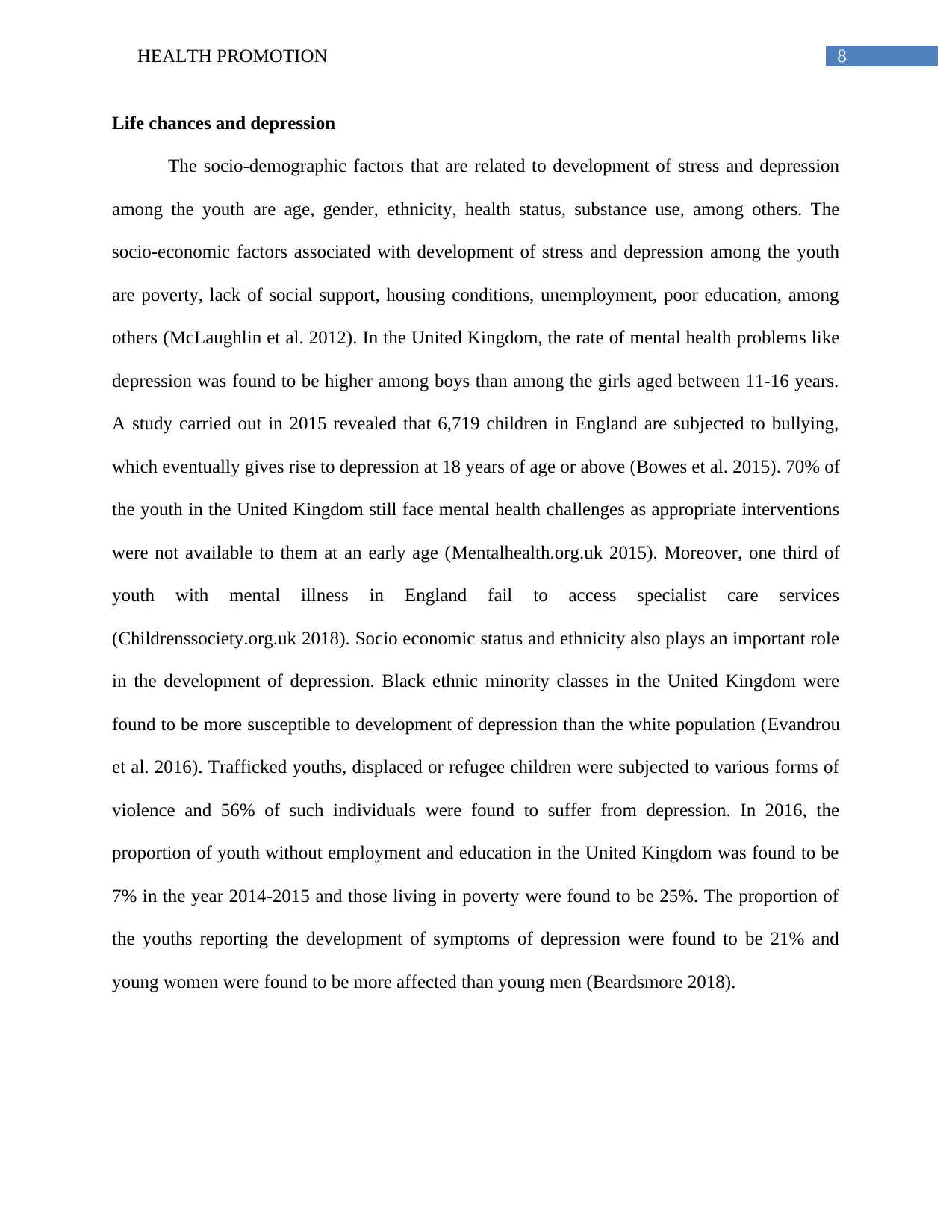
8HEALTH PROMOTION
Life chances and depression
The socio-demographic factors that are related to development of stress and depression
among the youth are age, gender, ethnicity, health status, substance use, among others. The
socio-economic factors associated with development of stress and depression among the youth
are poverty, lack of social support, housing conditions, unemployment, poor education, among
others (McLaughlin et al. 2012). In the United Kingdom, the rate of mental health problems like
depression was found to be higher among boys than among the girls aged between 11-16 years.
A study carried out in 2015 revealed that 6,719 children in England are subjected to bullying,
which eventually gives rise to depression at 18 years of age or above (Bowes et al. 2015). 70% of
the youth in the United Kingdom still face mental health challenges as appropriate interventions
were not available to them at an early age (Mentalhealth.org.uk 2015). Moreover, one third of
youth with mental illness in England fail to access specialist care services
(Childrenssociety.org.uk 2018). Socio economic status and ethnicity also plays an important role
in the development of depression. Black ethnic minority classes in the United Kingdom were
found to be more susceptible to development of depression than the white population (Evandrou
et al. 2016). Trafficked youths, displaced or refugee children were subjected to various forms of
violence and 56% of such individuals were found to suffer from depression. In 2016, the
proportion of youth without employment and education in the United Kingdom was found to be
7% in the year 2014-2015 and those living in poverty were found to be 25%. The proportion of
the youths reporting the development of symptoms of depression were found to be 21% and
young women were found to be more affected than young men (Beardsmore 2018).
Life chances and depression
The socio-demographic factors that are related to development of stress and depression
among the youth are age, gender, ethnicity, health status, substance use, among others. The
socio-economic factors associated with development of stress and depression among the youth
are poverty, lack of social support, housing conditions, unemployment, poor education, among
others (McLaughlin et al. 2012). In the United Kingdom, the rate of mental health problems like
depression was found to be higher among boys than among the girls aged between 11-16 years.
A study carried out in 2015 revealed that 6,719 children in England are subjected to bullying,
which eventually gives rise to depression at 18 years of age or above (Bowes et al. 2015). 70% of
the youth in the United Kingdom still face mental health challenges as appropriate interventions
were not available to them at an early age (Mentalhealth.org.uk 2015). Moreover, one third of
youth with mental illness in England fail to access specialist care services
(Childrenssociety.org.uk 2018). Socio economic status and ethnicity also plays an important role
in the development of depression. Black ethnic minority classes in the United Kingdom were
found to be more susceptible to development of depression than the white population (Evandrou
et al. 2016). Trafficked youths, displaced or refugee children were subjected to various forms of
violence and 56% of such individuals were found to suffer from depression. In 2016, the
proportion of youth without employment and education in the United Kingdom was found to be
7% in the year 2014-2015 and those living in poverty were found to be 25%. The proportion of
the youths reporting the development of symptoms of depression were found to be 21% and
young women were found to be more affected than young men (Beardsmore 2018).
⊘ This is a preview!⊘
Do you want full access?
Subscribe today to unlock all pages.

Trusted by 1+ million students worldwide

9HEALTH PROMOTION
Figure 1: Prevalence of mental illness (depression) among children based on
household income.
(Source: Mentalhealth.org.uk 2018)
Figure 1: Prevalence of mental illness (depression) among children based on
household income.
(Source: Mentalhealth.org.uk 2018)
Paraphrase This Document
Need a fresh take? Get an instant paraphrase of this document with our AI Paraphraser

10HEALTH PROMOTION
Figure 2: Prevalence of mental illness (depression) by socio-economic classification
(Source: Mentalhealth.org.uk 2018)
Barriers to mental health services
Some of the barriers to mental health services in the United Kingdom were found to be
limited provision of services and long waiting times. Other barriers include inadequate funding,
lack of access to care and lack of efficient and skilled workforce. Discrimination and stigma is
also a barrier to access mental health services. These include lack of knowledge, ignorance about
treatment and access, prejudice against individuals with mental illness and discrimination against
individuals with mental illness. Studies have shown the discrimination towards the black
minority ethnic community with respect to mental healthcare services (Memon et al. 2016;
Bma.org.uk 2017).
Evaluation of policies
The mental health foundation in the United Kingdom had provided a policy briefing with
respect to the promotion of mental health and well-being of the children and adolescents
(Mentalhealth.org.uk 2018). The National framework for mental health was created with support
from organizations like the centre for mental health, NHS confederation mental health network,
Mind, rethink mental illness and turning point. This framework was designed in order to obtain
favourable outcomes with respect to mental health in various regions of the United Kingdom
(Gov.uk 2018). One of the main aims of the mental health strategy was not only to ensure good
mental health and recovery, providing quality care but also to reduce the stigma and
discrimination associated with mental illnesses. Moreover, it also ensures access to mental health
Figure 2: Prevalence of mental illness (depression) by socio-economic classification
(Source: Mentalhealth.org.uk 2018)
Barriers to mental health services
Some of the barriers to mental health services in the United Kingdom were found to be
limited provision of services and long waiting times. Other barriers include inadequate funding,
lack of access to care and lack of efficient and skilled workforce. Discrimination and stigma is
also a barrier to access mental health services. These include lack of knowledge, ignorance about
treatment and access, prejudice against individuals with mental illness and discrimination against
individuals with mental illness. Studies have shown the discrimination towards the black
minority ethnic community with respect to mental healthcare services (Memon et al. 2016;
Bma.org.uk 2017).
Evaluation of policies
The mental health foundation in the United Kingdom had provided a policy briefing with
respect to the promotion of mental health and well-being of the children and adolescents
(Mentalhealth.org.uk 2018). The National framework for mental health was created with support
from organizations like the centre for mental health, NHS confederation mental health network,
Mind, rethink mental illness and turning point. This framework was designed in order to obtain
favourable outcomes with respect to mental health in various regions of the United Kingdom
(Gov.uk 2018). One of the main aims of the mental health strategy was not only to ensure good
mental health and recovery, providing quality care but also to reduce the stigma and
discrimination associated with mental illnesses. Moreover, it also ensures access to mental health
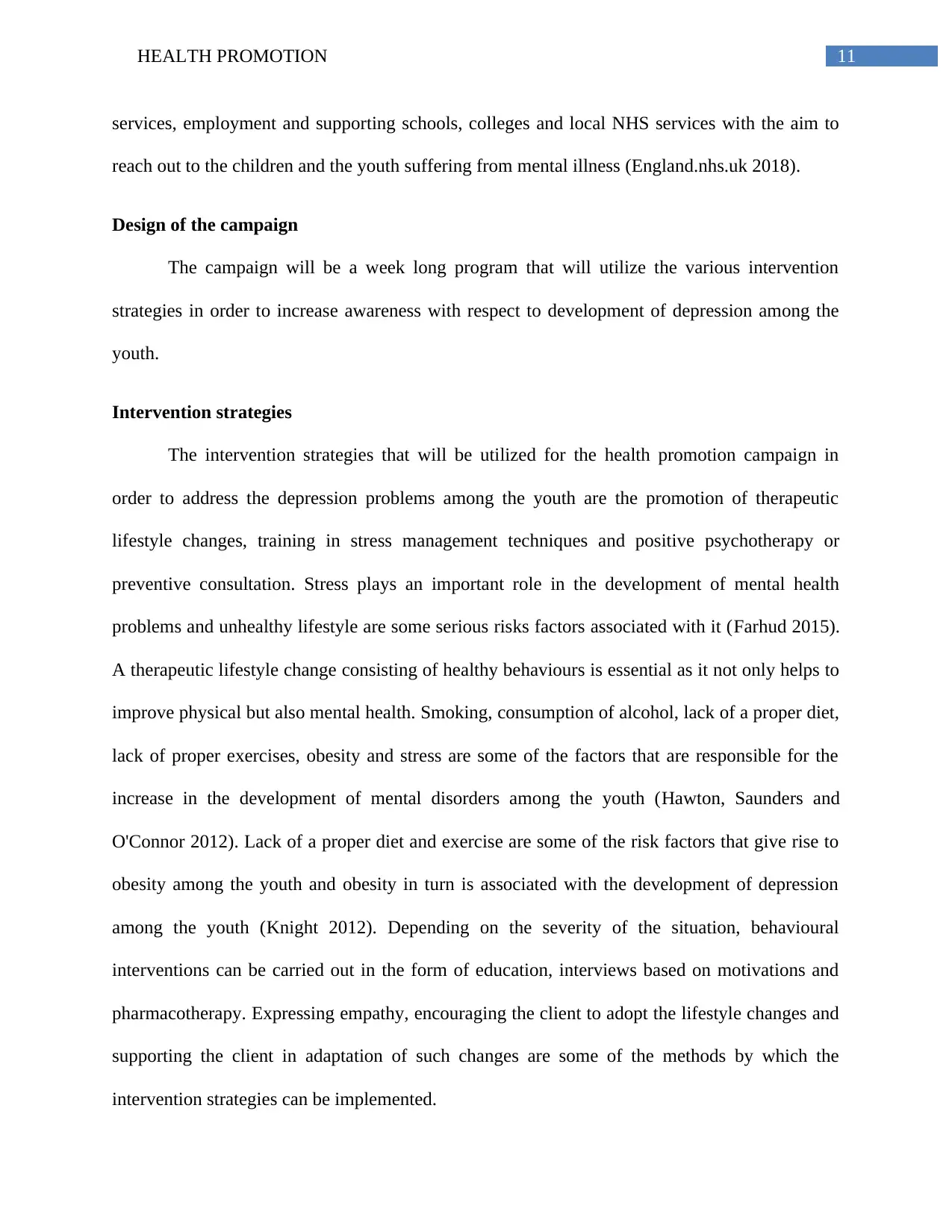
11HEALTH PROMOTION
services, employment and supporting schools, colleges and local NHS services with the aim to
reach out to the children and the youth suffering from mental illness (England.nhs.uk 2018).
Design of the campaign
The campaign will be a week long program that will utilize the various intervention
strategies in order to increase awareness with respect to development of depression among the
youth.
Intervention strategies
The intervention strategies that will be utilized for the health promotion campaign in
order to address the depression problems among the youth are the promotion of therapeutic
lifestyle changes, training in stress management techniques and positive psychotherapy or
preventive consultation. Stress plays an important role in the development of mental health
problems and unhealthy lifestyle are some serious risks factors associated with it (Farhud 2015).
A therapeutic lifestyle change consisting of healthy behaviours is essential as it not only helps to
improve physical but also mental health. Smoking, consumption of alcohol, lack of a proper diet,
lack of proper exercises, obesity and stress are some of the factors that are responsible for the
increase in the development of mental disorders among the youth (Hawton, Saunders and
O'Connor 2012). Lack of a proper diet and exercise are some of the risk factors that give rise to
obesity among the youth and obesity in turn is associated with the development of depression
among the youth (Knight 2012). Depending on the severity of the situation, behavioural
interventions can be carried out in the form of education, interviews based on motivations and
pharmacotherapy. Expressing empathy, encouraging the client to adopt the lifestyle changes and
supporting the client in adaptation of such changes are some of the methods by which the
intervention strategies can be implemented.
services, employment and supporting schools, colleges and local NHS services with the aim to
reach out to the children and the youth suffering from mental illness (England.nhs.uk 2018).
Design of the campaign
The campaign will be a week long program that will utilize the various intervention
strategies in order to increase awareness with respect to development of depression among the
youth.
Intervention strategies
The intervention strategies that will be utilized for the health promotion campaign in
order to address the depression problems among the youth are the promotion of therapeutic
lifestyle changes, training in stress management techniques and positive psychotherapy or
preventive consultation. Stress plays an important role in the development of mental health
problems and unhealthy lifestyle are some serious risks factors associated with it (Farhud 2015).
A therapeutic lifestyle change consisting of healthy behaviours is essential as it not only helps to
improve physical but also mental health. Smoking, consumption of alcohol, lack of a proper diet,
lack of proper exercises, obesity and stress are some of the factors that are responsible for the
increase in the development of mental disorders among the youth (Hawton, Saunders and
O'Connor 2012). Lack of a proper diet and exercise are some of the risk factors that give rise to
obesity among the youth and obesity in turn is associated with the development of depression
among the youth (Knight 2012). Depending on the severity of the situation, behavioural
interventions can be carried out in the form of education, interviews based on motivations and
pharmacotherapy. Expressing empathy, encouraging the client to adopt the lifestyle changes and
supporting the client in adaptation of such changes are some of the methods by which the
intervention strategies can be implemented.
⊘ This is a preview!⊘
Do you want full access?
Subscribe today to unlock all pages.

Trusted by 1+ million students worldwide
1 out of 24
Related Documents
Your All-in-One AI-Powered Toolkit for Academic Success.
+13062052269
info@desklib.com
Available 24*7 on WhatsApp / Email
![[object Object]](/_next/static/media/star-bottom.7253800d.svg)
Unlock your academic potential
Copyright © 2020–2025 A2Z Services. All Rights Reserved. Developed and managed by ZUCOL.





